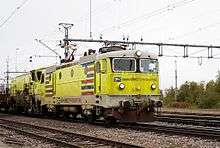Swedish Rail Administration
The Swedish Rail Administration (Swedish: Banverket) was a Swedish State administrative authority which acted as owner on behalf of the State and maintained virtually all main railway lines in Sweden; except for short sidings for freight, heritage railways, the Stockholm Metro, local railways in the Stockholm area (Roslagsbanan & Saltsjöbanan), and the tramways in Gothenburg, Norrköping and Stockholm. Its headquarters was located in Borlänge.
 | |
| State administrative authority (Swedish: Statlig förvaltningsmyndighet) | |
| Fate | Merged with the Swedish Road Administration |
| Predecessor | Swedish State Railways |
| Successor | Swedish Transport Administration |
| Founded | 1988 |
| Defunct | 31 March 2010 |
| Headquarters | , |
Area served | Sweden |
| Products | Rail infrastructure |
| Owner | The State (100%) |
| Website | www |
The Swedish Rail Administration was formed in 1988, when Swedish State Railways was split in two parts, leaving Statens Järnvägar as mainly a train operator ( both passenger and freight) and as a real estate owner, only to be split again in 2001.
The Swedish Railway Inspectorate (Swedish: Järnvägsinspektionen) was a part of the Swedish Rail Administration until 2004, when the Swedish Rail Agency (Swedish: Järnvägsstyrelsen) was formed, taking over its responsibilities. That agency was in turn incorporated into the newly formed Swedish Transport Agency (Swedish: Transportstyrelsen) in 2009.
In 2010, the Government directed a merger with the Swedish Road Administration (Swedish: Vägverket) to create the new Swedish Transport Administration (Swedish: Trafikverket), and the subsidiary responsible for railway maintenance was spun off in a separate aktiebolag, Infranord.
List of Directors-General
- Jan Brandborn 1988-1995
- Monica Andersson 1995-1997
- Bo Bylund 1997-2005
- Per-Olof Granbom 2006-2008
- Minoo Akhtarzand 2008-2010